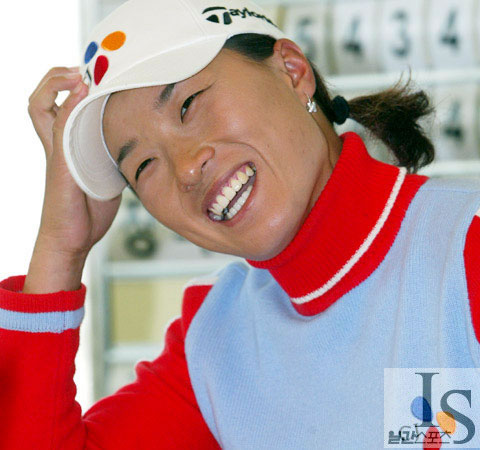 |
 |
 |
 |
 |
 |
Se Ri Pak: An Appreciation
Quotes, Gallery1, Gallery2
Exclusives, Results
 Many
opined that Se Ri was finished, that all this attention had been too much
for her. But for the first of many times in her career, she proved the
critics wrong. Her start in 1999 was hardly stellar, but eventually she
recovered and won four more tournaments that year, finishing third on
the money list. She had another downturn in 2000 when she tried to operate
without a regular coach, but after struggling much of that year, she hired
a new coach that September and promptly won the first event of the 2001
season. She came back even stronger than she had been before, winning
five times that year, and added five more wins in 2002. By this time she
was clearly the number two player in the game; now all that remained was
to figure out some way to topple Annika Sorenstam from the top spot. But
in the meantime, she was still setting records, playing brilliantly, and
providing a role model for the young Koreans coming over.
Many
opined that Se Ri was finished, that all this attention had been too much
for her. But for the first of many times in her career, she proved the
critics wrong. Her start in 1999 was hardly stellar, but eventually she
recovered and won four more tournaments that year, finishing third on
the money list. She had another downturn in 2000 when she tried to operate
without a regular coach, but after struggling much of that year, she hired
a new coach that September and promptly won the first event of the 2001
season. She came back even stronger than she had been before, winning
five times that year, and added five more wins in 2002. By this time she
was clearly the number two player in the game; now all that remained was
to figure out some way to topple Annika Sorenstam from the top spot. But
in the meantime, she was still setting records, playing brilliantly, and
providing a role model for the young Koreans coming over.
In 2003, she accomplished something no women had done in over fifty years. She played a men's golf tournament (on the Korean PGA tour), and made the cut. But not only made the cut: she finished tenth. In the hype about other women playing men's golf events, it should never be forgotten that Se Ri was the first one in modern times to accomplish this, and she did it on her first and only attempt.
After scoring the final win to qualify for the LPGA Hall of Fame in 2004,
Se Ri crashed. She was completely burned out, unable to generate any enthusiasm
for the game any more. Her results got progressively worse, bottoming
out in a horrible appearance at the Samsung Championship in which she
finished in last place, 15 shots behind the second to last place golfer.
Her game was a shambles. Then the injuries came, and even when she wanted
to play, she was not able to. Many wondered if, this time, Se Ri Pak was
through. Even in her previous slumps, she had still clearly been a top
20 golfer. Now, she was not even in the top 100. In those previous slumps,
she might not win, but she would still score several top tens in a season.
Now, she could not even score a single top twenty. Few golfers had ever
recovered from so vicious a trough. Her interviews of the time reflect
her ennui: she would talk about needing to get away from the game, finding
hobbies, outside activity, anything but hitting a small white ball with
a metal club.
 The
tough little girl from the wrong side of the tracks in Daejeon, Korea,
had survived difficult times before. But could she overcome herself, always
the toughest obstacle for any person to face? After an injury forcibly
sidelined her for several months, she had her answer. She found those
new activities she was looking for, and reconnected with friends, many
of whom she didn't know she had. She forgot all about golf. By the time
she was over her injuries, she was hungry again, eager to tackle the challenge
of trying to get back to the top. Eight months later, she stood atop the
golf world again, following a brilliant performance at the 2006 LPGA Championship,
during which she slugged it out with half a dozen other top golfers on
Sunday, survived a near disastrous three putt on the final hole, and won
a playoff with one of her fiercest rivals by hitting arguably the greatest
shot of her career. Once again, she was on top, and once again, she was
an example for the other Korean golfers to follow. Only now, the lessons
she taught were: never give up, find balance, appreciate what you have,
spend time with your friends.
The
tough little girl from the wrong side of the tracks in Daejeon, Korea,
had survived difficult times before. But could she overcome herself, always
the toughest obstacle for any person to face? After an injury forcibly
sidelined her for several months, she had her answer. She found those
new activities she was looking for, and reconnected with friends, many
of whom she didn't know she had. She forgot all about golf. By the time
she was over her injuries, she was hungry again, eager to tackle the challenge
of trying to get back to the top. Eight months later, she stood atop the
golf world again, following a brilliant performance at the 2006 LPGA Championship,
during which she slugged it out with half a dozen other top golfers on
Sunday, survived a near disastrous three putt on the final hole, and won
a playoff with one of her fiercest rivals by hitting arguably the greatest
shot of her career. Once again, she was on top, and once again, she was
an example for the other Korean golfers to follow. Only now, the lessons
she taught were: never give up, find balance, appreciate what you have,
spend time with your friends.
One year after her amazing comeback victory, Se Ri Pak found herself back at the scene of her triumph, this time to celebrate a very different achievement. At long last, she had completed the requirements to enter the LPGA Hall of Fame, and she had done it several months before the age of thirty. She has truly been one of the transcendent sports figures of her generation. She has seen spectacular highs and crushing lows. She rose from the difficult circumstances to conquer her nation, and then redefined the limits of what her countrywomen could do by going where none of them had gone before. Through it all, she has been the embodiment of class and style, always taking time to give back to charities and to lend a helping hand to her fellow younger golfers who were trying to follow in her footsteps in America. And then, as if that were not enough, she overcame adversity that would have floored most to again rise to the top of her profession, all the while discovering the importance of balance in life. Once again, in 2007 as in 1998, she was leading the pack and setting example for all her countrywomen to follow.
And then there's the legacy of Se Ri. It's hard to even think of legacy when you consider she may be a top golfer for a decade or more yet to come, but it cannot be denied: few athletes in history have had a more profound impact on his or her sport than has Se Ri. You see her legacy every time you watch Na On Min string together four straight birdies to nearly win the LPGA Championship, or Seon Hwa Lee smoothly sink a perfect putt into the hole to claim the Lexus Cup, or Jee Young Lee pound a 300 yard drive down the fairway. For every one of those women, and many more to come, Se Ri has been the inspiration that drove them to succeed: 'if Se Ri could do it, maybe I can, too'. Se Ri might officially be a Hall of Famer only as of this week, but in reality, she has been one for some time.
Three cheers for Se Ri Pak, the newest member of the LPGA and World Golf Halls of Fame. Long may she continue to play, and here's hoping that indeed, as she has said on several occasions, this is truly 'only the beginning'.
